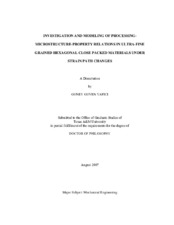| dc.description.abstract | Ultra-fine grained (UFG) materials have attracted considerable interest due to the possibility of achieving simultaneous increase in strength and ductility. Effective use of these materials in engineering applications requires investigating the processing-microstructure-property inter-relations leading to a comprehensive understanding of the material behavior. Research efforts on producing UFG hexagonal close packed (hcp) materials have been limited in spite of their envisaged utilization in various technologies. The present study explores multiple UFG hcp materials to identify the general trends in their deformation behaviors, microstructural features, crystallographic texture evolutions and mechanical responses under strain path changes. UFG hcp materials, including commercial purity Ti, Ti-6Al-4V alloy and high purity Zr, were fabricated using equal channel angular extrusion (ECAE) as a severe plastic deformation (SPD) technique following various processing schedules. Several characterization methods and a polycrystal plasticity model were utilized in synergy to impart the relationships between the UFG microstructure, the texture and the post-ECAE flow behavior. Pure UFG hcp materials exhibited enhanced strength properties, making them potential substitutes for coarse-grained high strength expensive alloys. Incorporation of post-ECAE thermo-mechanical treatments was effective in further improvement of the strength and ductility levels. Strong anisotropy of the post-ECAE flow response was evident in all the materials studied. The underlying mechanisms for anisotropy were identified as texture and processing-induced microstructure. Depending on the ECAE route, the applied strain level and the specific material, the relative importance of these two mechanisms on plastic flow anisotropy varied. A viscoplastic self-consistent approach is presented as a reliable model for predicting the texture evolutions and flow behaviors of UFG hcp materials in cases where texture governs the plastic anisotropy. Regardless of the material, the initial billet texture and the extrusion conditions, ECAE of all hcp materials revealed similar texture evolutions. Accurate texture and flow behavior predictions showed that basal slip is the responsible mechanism for such texture evolution in all hcp materials independent of their axial ratio. High strength of the UFG microstructure was presented as a triggering mechanism for the activation of unexpected deformation systems, such as high temperature deformation twinning in Ti-6Al-4V and room temperature basal slip in pure Zr. | en |


